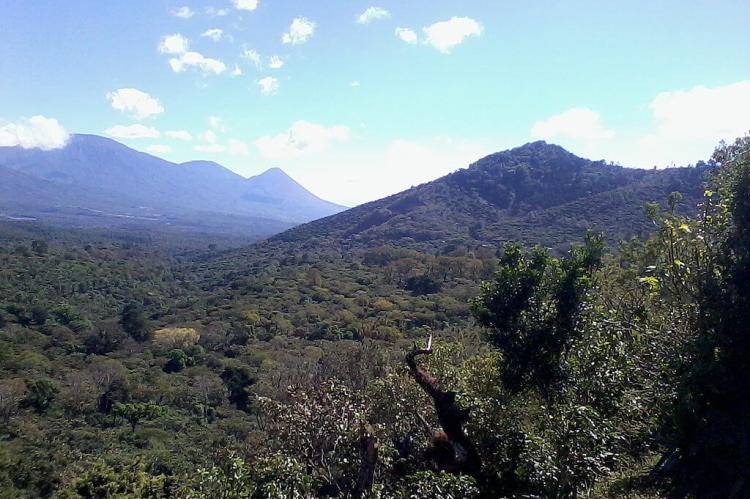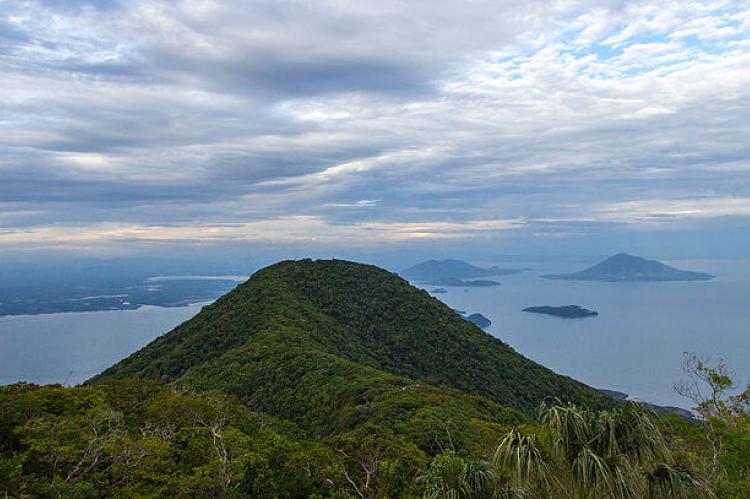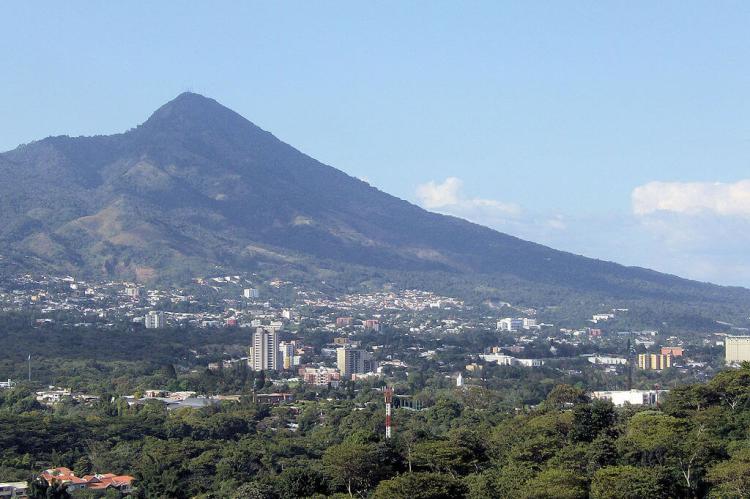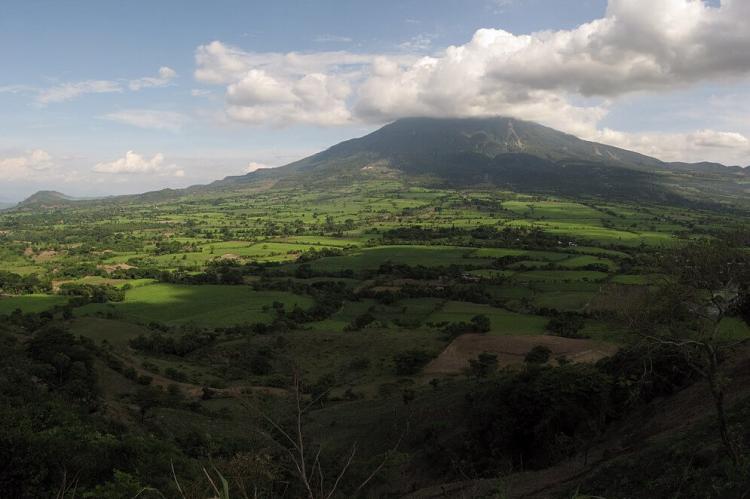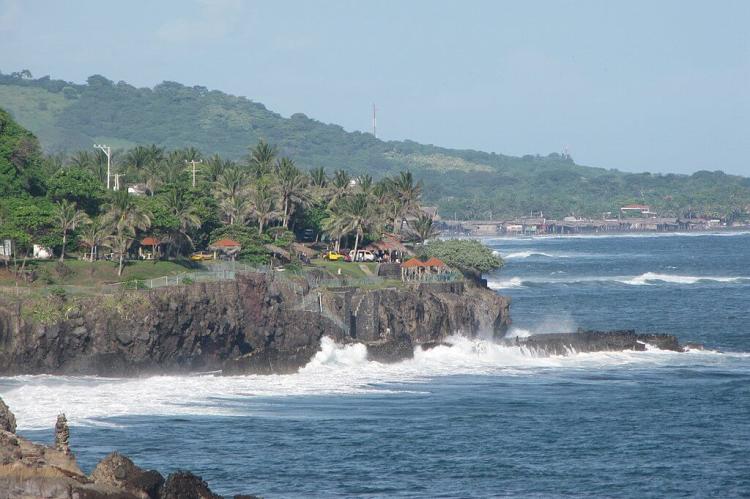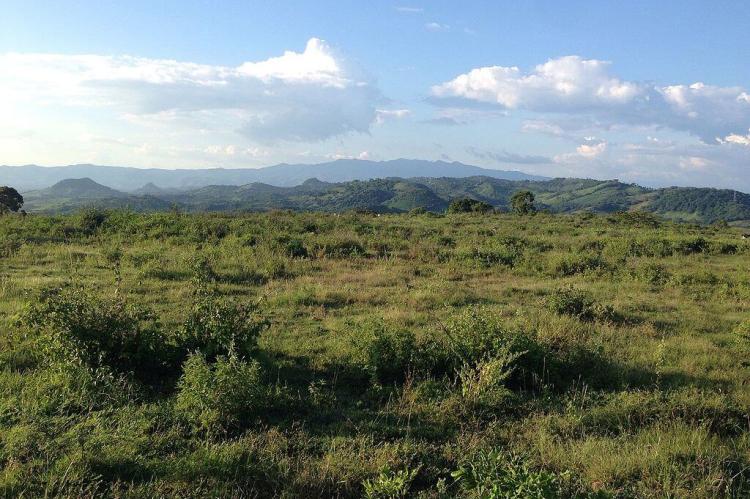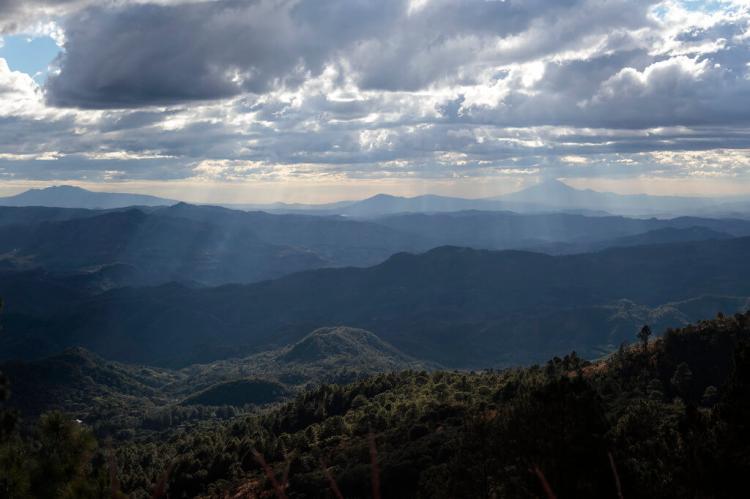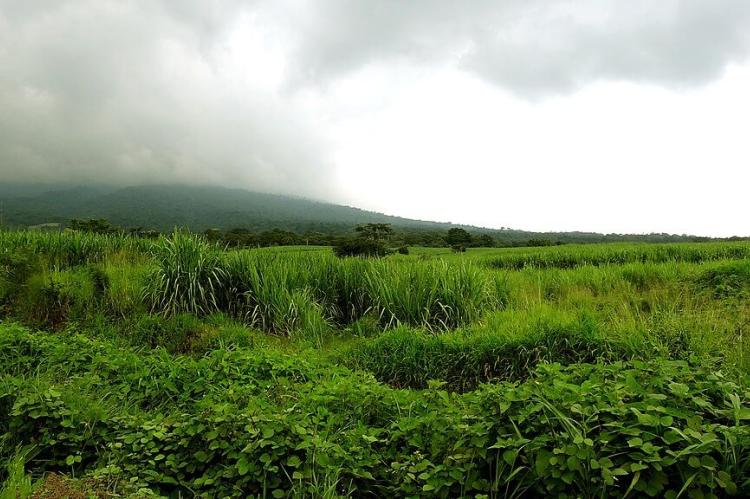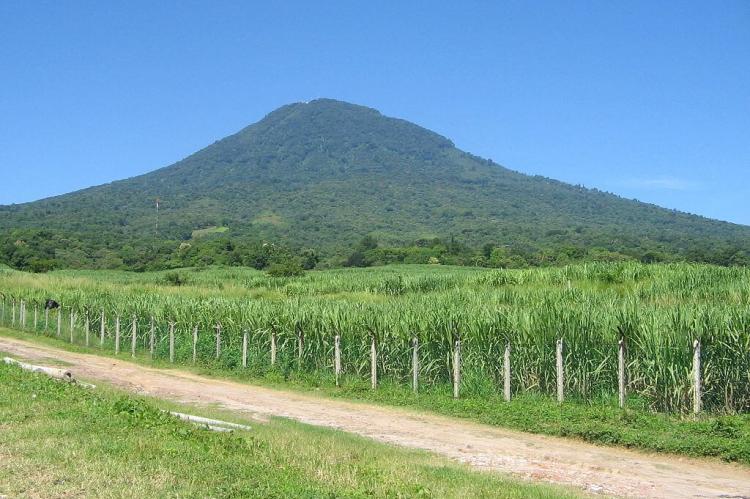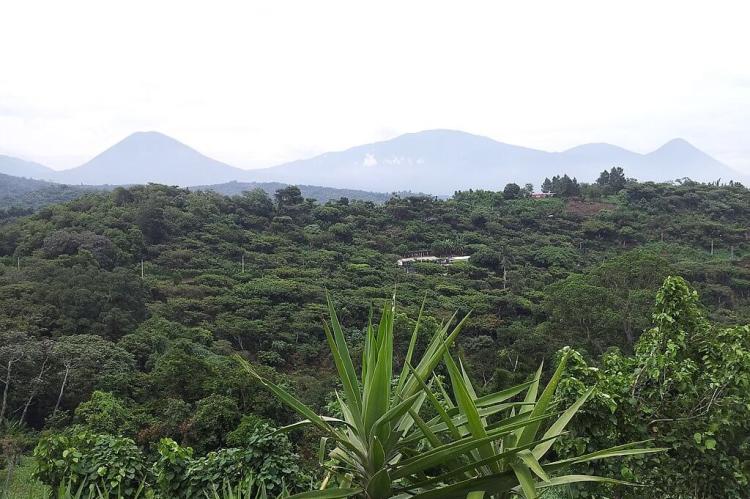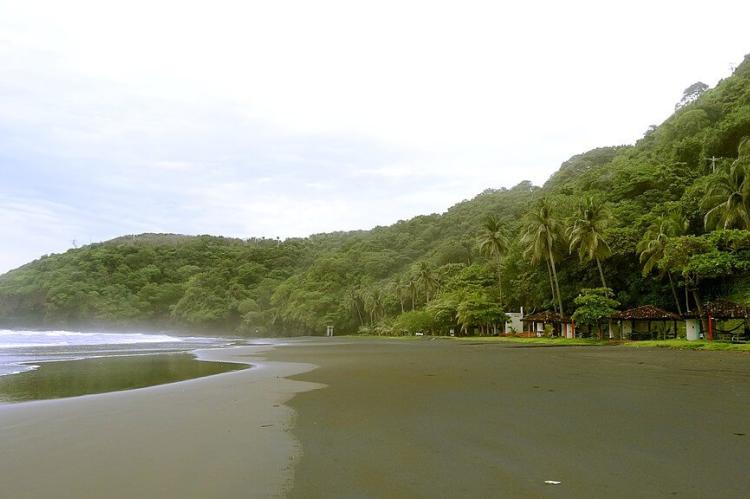El Salvador: Natural Landscape
El Salvador is located in northern Central America, where it is both the smallest and most densely populated country. Its geographic landscape features two parallel mountain ranges that cross the country with a central plateau between them and a narrow coastal plain hugging the Pacific Ocean.
The Natural Landscape of El Salvador
Nestled in northern Central America, El Salvador is strategically positioned, sharing borders with Honduras to the northeast and Guatemala to the northwest. Its geographic location grants it access to the Pacific Ocean and the Gulf of Fonseca, stretching across approximately 307 kilometers (191 miles) of coastline. This unique positioning makes El Salvador the only country in Central America without a shoreline on the Caribbean Sea.
With a total land area of 21,041 square kilometers (8,124 square miles), El Salvador is the smallest country in Central America. Its compact size belies its remarkable diversity, with landscapes ranging from lush rainforests to towering volcanoes. Spanning 270 kilometers (168 miles) from west-northwest to east-southeast and 142 kilometers (88 miles) from north to south, El Salvador is also Central America's most densely populated country.
The Pan-American Highway, CA-1 or Carretera Panamericana, is the nation's main road, connecting El Salvador with its neighboring countries. Traversing the country from west to east, this vital transportation artery facilitates the movement of people and goods, playing a crucial role in El Salvador's economy and development.
El Salvador's geographic position and diverse landscapes have shaped its rich cultural heritage and economic activities. Its access to the Pacific Ocean and the Gulf of Fonseca has fostered a vibrant coastal culture, while its fertile lands support agriculture and coffee production. The country's natural beauty and unique ecosystems have also attracted ecotourism, providing sustainable development and economic growth opportunities.
Biodiversity
El Salvador, though modest in size, harbors a surprising array of ecosystems and species, contributing to its unique biodiversity. While not in the spotlight like some larger neighbors, the country hosts a rich mosaic of life.
Ranked as the 70th most biodiverse nation globally by the Global Biodiversity Index, El Salvador showcases its environmental wealth with 495 bird species, 30 amphibian species, 588 fish species, 156 mammal species, 135 reptile species, and an impressive 2,911 species of vascular plants. These numbers underscore the ecological diversity tucked within the nation's boundaries.
Conservation
In El Salvador, conservation efforts are paramount to safeguard the country's limited natural resources and preserve its biodiversity. Despite its small size and high population density, El Salvador has embraced the responsibility of environmental stewardship, recognizing the intrinsic value of its ecosystems.
Challenges to conservation in this dynamic Central American nation are manifold. Urbanization, pollution stemming from industry and agriculture, over-exploitation of natural resources, and the growing impacts of climate change present formidable hurdles. The limited land area and heightened population density further magnify the urgency of addressing these challenges.
Despite these obstacles, El Salvador is committed to balancing development with conservation. Through strategic measures and a proactive stance, the country endeavors to ensure that its ecological treasures endure for future generations, fostering a delicate equilibrium between progress and
Climate
El Salvador's climate is characterized by a tropical warmth, with temperatures primarily dictated by elevation rather than distinct seasonal shifts. However, the country experiences different wet and dry seasons that shape its agricultural rhythms and natural landscapes.
El Salvador experiences its wet season and abundant rainfall from May to October. During this time, afternoon and evening showers are common, turning the land into lush greenery. In contrast, the dry season from November to April provides a break from the showers, with lower humidity and reduced rainfall. Despite the drier period, the country still receives some precipitation, ensuring a consistent water supply for its residents and ecosystems.
The average temperature in El Salvador is 25 °C (77 °F), but it can vary depending on the altitude and the time of year.
-
The Pacific coast of El Salvador is the hottest and most humid region of the country, with temperatures averaging around 27 °C (81 °F) year-round.
-
The central highlands are cooler and drier, with temperatures averaging around 22 °C (72 °F).
-
The northern mountains are the coolest region of the country, with temperatures averaging around 18 °C (64 °F).
El Salvador's climate is not without its challenges. The country lies within the hurricane belt, making it vulnerable to the wrath of these powerful storms. Hurricanes and tropical cyclones can wreak havoc on infrastructure, disrupt agriculture, and displace communities. Despite these risks, El Salvador's climate remains a defining feature of its identity, shaping its landscapes, influencing its culture, and contributing to its rich biodiversity.
Volcanism
El Salvador, situated within the Pacific Ring of Fire, a region renowned for its volcanic activity, is home to numerous volcanoes and volcanic structures that have shaped its landscapes and geology. Like the rest of Central America, the relatively stable Caribbean Plate is underneath El Salvador. The subduction of the Cocos Plate to the west beneath the Caribbean Plate to the east is responsible for the high frequency of earthquakes and volcanic eruptions in the region.
Along the Central American Volcanic Arc, which spans the territory of El Salvador, there are approximately twenty volcanoes. However, only Izalco, Santa Ana, and San Miguel have been recently active. While El Salvador's volcanoes offer benefits like geothermal energy resources and fertile volcanic soils for agriculture, they also present challenges. The proximity of human settlements to active volcanoes introduces potential risks, necessitating a balanced approach to harnessing the advantages while ensuring the population's safety.
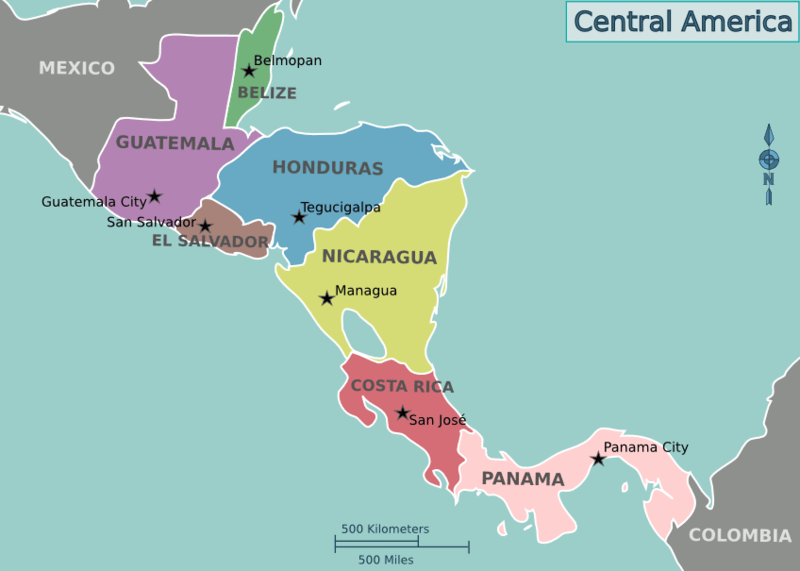
Location map of the countries of Central America.
Natural Geography of El Salvador
El Salvador's geography is a captivating interplay of mountain ranges, plateaus, and coastal plains shaped by the forces of nature over millennia. Two parallel mountain ranges traverse the country from west to east, enclosing a central plateau and leaving a narrow coastal plain along the Pacific Ocean. This unique topography divides the country into three distinct geographic regions:
-
Northern Lowlands
-
Central Plateau or Highlands, surrounded by volcanoes
-
Pacific Coastal Belt
Northern Lowlands (La Zona Norte)
Stretching along the border with Honduras, the Sierra Madre mountain range defines the northern lowlands of El Salvador. Parallel to these mountains, a vast interior plain unfolds at elevations ranging from 400 to 600 m (1,300 to 2,000 ft). Once covered in forests, this interior plain has undergone significant transformation and now bears the marks of erosion from overexploitation. The consequences are evident in its semi-barren state today. Once rich in biodiversity, this area is now the country's most sparsely populated zone, illustrating the delicate balance between human activities and the preservation of natural landscapes.
Central Highlands (La Zona Central)
The central highlands prominently shape El Salvador's landscape, featuring a west-east discontinuous chain of volcanoes; some are currently active and categorized into five groups. This volcanic range encompasses a total of 20 cones. Beginning with the westernmost group near the Guatemalan border, notable peaks include Izalco and Santa Ana. The chain continues through San Salvador and San Miguel, reaching its easternmost point with the Conchagua group. These volcanoes are separated by alluvial basins and rolling hills, collectively known as the central plain. Positioned at elevations ranging from 1,000 to 1,500 m (3,500 to 5,000 ft), these plains feature fertile soils that have supported agriculture for an extended period.
Coastal Belt (La Costa)
Southward, as the central highlands yield to the Pacific coast, emerges a slender coastal plain characterized by average elevations ranging from 30 to 150 m (100 to 500 ft). The width of this coastal belt varies from 1 to 32 km (.5 to 20 mi), with the broadest section situated in the east, adjacent to the Gulf of Fonseca.
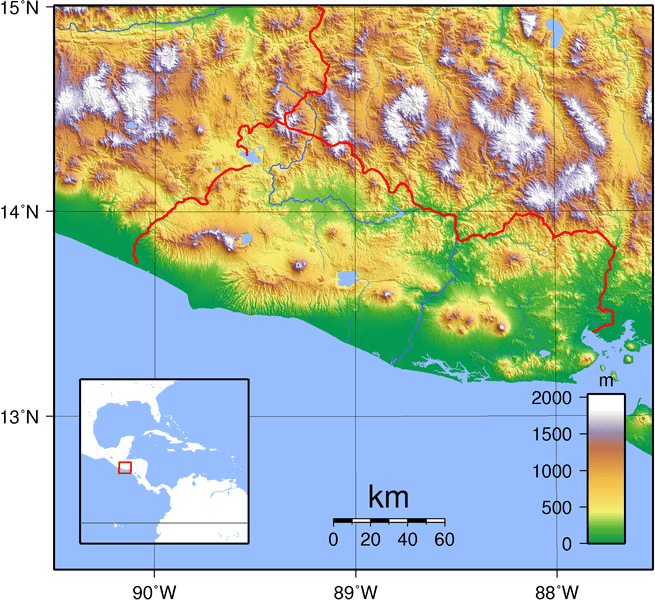
Topographic map of El Salvador.
Islands
El Salvador has a relatively short coastline along the Pacific Ocean, with a few islands and islets. These islands are relatively low-lying and have played a role in local fishing and economic activities. They contribute to the coastal geography of the country, albeit on a smaller scale compared to some other countries in the region. The most notable of these islands include:
-
Isla Montecristo: Isla Montecristo, also known as Isla Tigre, is a large island in the Gulf of Fonseca, off the coast of El Salvador. It is the largest island in the country, with a total land area of 133 sq km (51 sq mi). The island is home to various wildlife, including monkeys, sloths, and birds.
-
Meanguera del Golfo: Meanguera del Golfo is an island in the Gulf of Fonseca. It is the second-largest island in El Salvador, with a total land area of 16.68 sq km (6.47 sq mi). The island is home to a population of about 2,400 people.
-
Isla Martín Perez: Isla Martín Pérez, also known as Isla Martín Pérez, is a small island located in the Gulf of Fonseca, off the coast of El Salvador, with a total land area of just two sq km (0.8 sq mi). The island's population is about 1,000, and the main town is El Real de la Isla.
Bodies of Water
El Salvador, bordered by the Pacific Ocean, is home to diverse water bodies contributing to its natural beauty and ecological significance. From expansive lakes and picturesque lagoons to bays, gulfs, and meandering rivers, these bodies of water shape the landscape and play essential roles in the country's ecosystem, economy, and recreational activities.
See more: Water Bodies of El Salvador
Administrative Divisions
El Salvador has 14 departments, each of which is administered by a governor appointed by the president. Each of the 14 departments has a capital city and is subdivided into 262 municipalities.
See more: Cultural Landscape of El Salvador
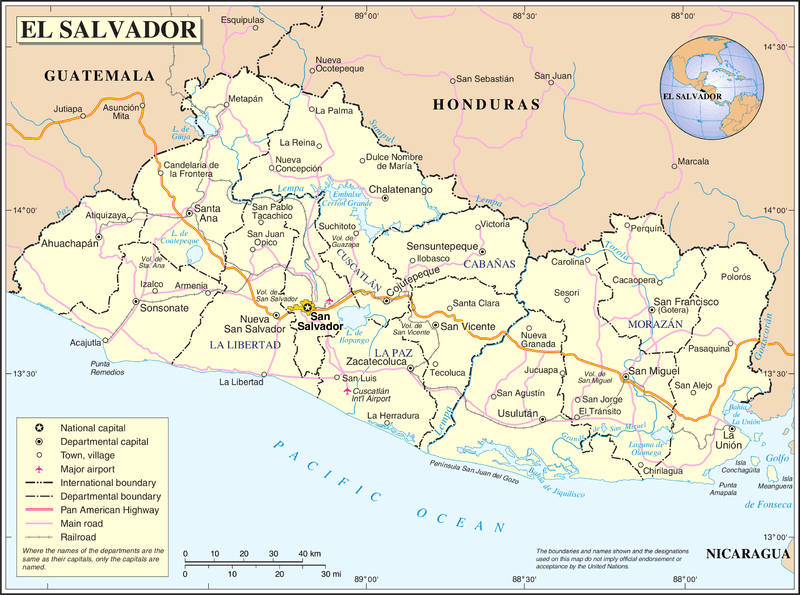
Map of El Salvador.
Natural Regions
Flora and Fauna
The country boasts an abundance of flora and fauna, some of which have been classified as either threatened or vulnerable. Four of the world's eight sea turtles nest on the coast of El Salvador, including the critically endangered hawksbill.
Ecological Regions
The following is a list of terrestrial ecoregions in El Salvador, as defined by the World Wide Fund for Nature (WWF). El Salvador is in the Neotropical realm. Ecoregions are classified by biome type - the major global plant communities determined by rainfall and climate.
Tropical and subtropical moist broadleaf forests
Tropical and subtropical coniferous broadleaf forests
Tropical and subtropical coniferous dry forests
Mangroves
-
Gulf of Fonseca mangroves
-
Northern Dry Pacific Coast mangroves
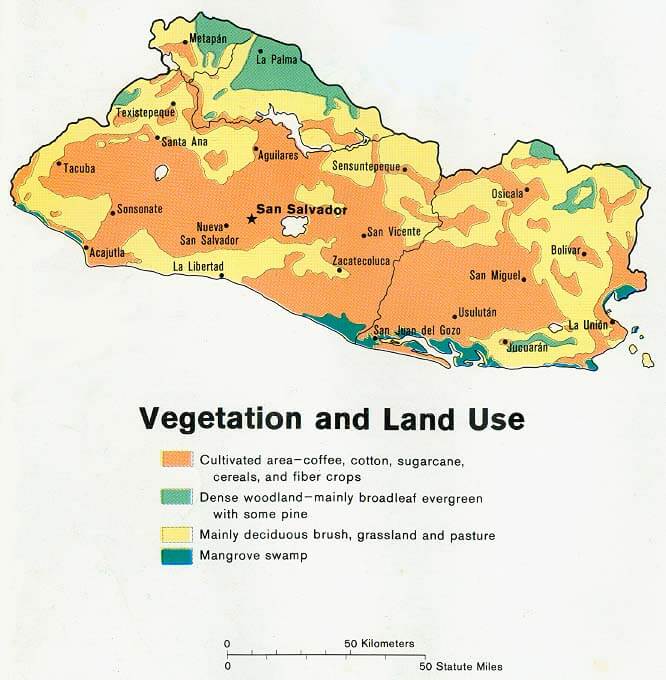
Vegetation and land use map of El Salvador.
